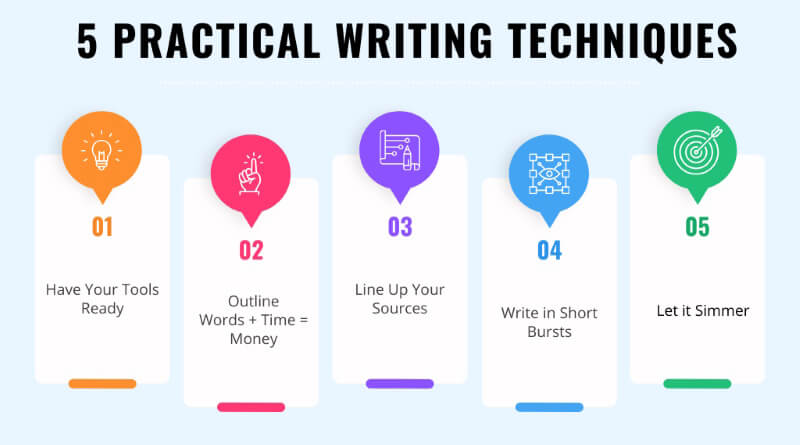5 Practical Writing Techniques to Double Your Productivity

Tired of sitting at your laptop for hours with only a few paragraphs to show for it? Missing deadlines because you can’t seem to keep up? Frustrated because you know you could be more productive, if only…?
Join the club. We’ve all been there. Sometimes a few times a day.
Fortunately, there is hope in the way of several writing techniques that can help you work more efficiently and be more productive. Here are five very practical writing techniques that have helped me become a more productive writer. I hope they help you, too.
1. Have Your Tools Ready
Laptop charged? Check. Google Docs open? Check. Favorite tools bookmarked? Check. Coffee? Check.
Okay, go.
All of the writing techniques in the world can’t increase your productivity if you’re getting up to find your glasses or searching for that handy site you use to create graphics. What was that site called again? If you had it bookmarked, you’d already have it opened.
Tools vary from writer to writer. No matter what you require, make sure you have it all close at hand so you don’t waste precious writing time later.
2. Outline
I used to think outlines were only for novices and novelists. Now, I refuse to work without one. What changed? I got tired of wasting words.
If you find yourself writing well beyond your target word count then slashing them heavily to fit, you’re wasting words. If you find yourself rambling on one topic and struggling on another, you’re wasting words and time.
If you are just starting out as a writer, let me save you years of headache and unpaid bills. Memorize this simple formula:
Words + Time = Money
Wasting words is a waste of money, and you can’t afford it. The solution is to outline your work first, then fill in the blanks systematically. My outlines are very basic and go something like this:
- Jot down the title and target word count at the top of the page
- Write down simple headings for topics I want to cover
- Write a single sentence under each heading describing points I want to make
It’s very simple, but once it’s done I know what I want to say and where I want to say it. My wallet—and my readers—thank me. This Writtent blog post talks more about outlines and productivity.
3. Line Up Your Sources
Do your research, find trusted sources to back up your points, drag links to your page, and have it all in your head and ready to refer to. Doing this helps keep your writing sharp and on topic.
4. Write in Short Bursts
This means two different things. The first meaning is to give yourself breaks, say once every hour or so. Writing is creative brainwork, and can be mentally exhausting if you don’t let your mind “wander” regularly. Copyblogger talks more about being a more creative, productive writer.
The second meaning is to write in short bursts under each heading. Going back and forth between topics is one of the best writing techniques to keep your word count under control and your content concise.
Example: While writing this blog post, I first wrote a short paragraph or two under each heading. I then went back and forth between topics, adding relevant information to each until I came pretty close to my target word count. Remember, words equal money and concise copy captures readers. It’s a win/win.
5. Let it Simmer
In a hurry to submit for a deadline? Don’t be.
This is a writing technique I still struggle with, but following this rule helps catch errors every time:
- Let your finished piece sit for at least one hour before you perform a final edit.
When you go back after “the simmer” and read the copy word-for-word, you’ll be more likely to catch errors that slipped right past you on previous passes. Read more about editing your own work over at Constant Content.
There you have it. Those are the writing techniques that have helped me grow and be more productive as a copywriter and ghostwriter. Have you found them to be useful? Would you add anything? Please let me know in the comments!

Comments (0)